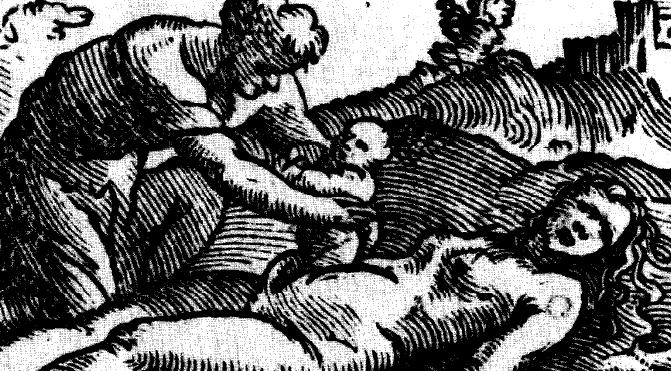First C-section and Pig Gelding December 18, 2010
Author: Beach Combing | in : Ancient, Medieval, Modern , trackbackBeachcombing is presently watching his beloved village disappear under that ghastly white stuff called snow.
Mrs B., meanwhile, is running around with Little Miss B. upstairs in a state of wide-eyed childish bliss. She seems to have forgotten that, given she is now eight and a half months pregnant and given that the nearest hospital is ten miles away through blocked roads, the family risks returning to the birth procedures of the nineteenth century. All that Beachcombing needs now is a pioneer sort ordering him to go and boil some hot water…
This got Beachcombing thinking about the terrible risks attendant on childbirth in previous millennia. Today the modern world splits women easily into fertile and infertile. But we forget that well into the twentieth century there was another pairing: birth-capable and birth-incapable.
The birth-capable could conceive and give birth. The birth incapable – a very unlucky minority of perhaps five percent – could conceive and nurture a baby within them, but, when the moment came, were not capable of expelling the child and lost their own and their child’s lives.
Beachcombing recalls a terrifying description from the letters of Marco Datini (obit 1410), merchant of Prato, as one of his serving maids tried and failed to give birth over three days.
Surely there are few worse deaths?
Today the birth incapable are still very much with us, but are given a local anaesthetic and a surgeon is called in. Many children who have been brought into the world without the trauma of a normal birth are not even aware of the fact, the procedure being so routine. Indeed, doctors talk to their victims about a friendly ‘C-section’ instead of the more officious and frightening ‘caesarean’.
But when did C-sections begin?
Beachcombing first must make a distinction here. Opening the womb with a sharp object and retrieving a child from his or her mother must have been part of life from prehistoric times – though it would be interesting to find the first reliable written or pictorial record. So the use of the Latin name Posthumus should mean born after the death of the mother: it can, in fact, also mean born after the death of the father. Curiously, the name Caesar has nothing to do with cutting or Caesarean sections pace Pliny.
However, Beachcombing’s own definition of a C-section is a medical procedure – not an act of butchery – where child and mother make it out alive.
Beachcombing should also warn the unwary bizarrist against the wiles of mythology: several culture heroes were reportedly ‘unborn’, being cut from their mother’s womb – think Macduff. The unborn like the undead are though privileged in our mythic systems and in many cases this will have been retrospective projection by pious or bawdy biographers.
The first reference that Beachcombing has found that sounds half credible is to Jacob Nufer, c. 1500. Jacob, a Swiss pig gelder, who stepped in with his steel knife after his wife had been in labour for several days and thirteen midwifes had failed to deliver the baby. His wife and the child survived and the new mother had five more children afterwards!
The story was recorded in 1582, a little late, and Beachcombing’s alarm bells went off as soon as he read ‘thirteen’ (unlucky for some) and the detail that Jacob worked with pigs, never mind the five extra sprogs. In mythology swine-herds often turn up in unusual roles. What are the odds that this is – sorry Jacob! – hog tripe?
One historian of caesarean sections writes:
‘Many of the earliest successful cesarean sections took place in remote rural areas lacking in medical staff and facilities. In the absence of strong medical communities, operations could be carried out without professional consultation. This meant that cesareans could be undertaken at an earlier stage in failing labor when the mother was not near death and the fetuswas less distressed. Under these circumstances the chances of one or both surviving were greater. These operations were performed on kitchen tables and beds, without access to hospital facilities, and this was probably an advantage until the late nineteenth century.Surgery in hospitals was bedeviled by infections passed between patients, often by the unclean hands of medical attendants. These factors may help to explain such successes as Jacob Nufer’s.’
Is this too trusting?
Caesarean sections were already employed routinely in the eighteenth century but with little success: ‘According to one estimate not a single woman survived cesarean section in Paris between 1787 and 1876.’ Only by the early twentieth century – with anaesthetic, antibiotics, sterile tools and good suturing – would the threatening caesarean become the relaxed c-section.
It would still put Beachcombing’s racing mind at rest if there was a better evinced procedure than Jacob the pig gelder. Any suggestions would be gladly received: drbeachcombing AT yahoo DOT com
Is it possible that the first reliably recorded western example comes from the eighteenth century?
Beachcombing’s blood pressure has raced up while writing the post and yet Mrs B and Little Miss B are still happily playing upstairs. Outside the blizzard is swirling and the fire hydrants are disappearing under the dreadful white powder. Could a helicopter land in the village car park? Watch this space…



